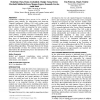Free Online Productivity Tools
i2Speak
i2Symbol
i2OCR
iTex2Img
iWeb2Print
iWeb2Shot
i2Type
iPdf2Split
iPdf2Merge
i2Bopomofo
i2Arabic
i2Style
i2Image
i2PDF
iLatex2Rtf
Sci2ools
CHI
2005
ACM
2005
ACM
Visualization in law enforcement
Visualization techniques have proven to be critical in helping crime analysis. By interviewing and observing Criminal Intelligence Officers (CIO) and civilian crime analysts at the Tucson Police Department (TPD), we found that two types of tasks are important for crime analysis: crime pattern recognition and criminal association discovery. We developed two separate systems that provide automatic visual assistance on these tasks. To help identify crime patterns, a Spatial Temporal Visualization (STV) system was designed to integrate a synchronized view of three types of visualization techniques: a GIS view, a timeline view and a periodic pattern view. The Criminal Activities Network (CAN) system extracts, visualizes and analyzes criminal relationships using spring-embedded and blockmodeling algorithms. This paper discusses the design and functionality of these two systems and the lessons learned from the development process and interaction with law enforcement officers. Author Keywords...
CHI 2005 | Civilian Crime Analysts | Crime Analysis | Crime Pattern Recognition | Human Computer Interaction |
| Added | 30 Nov 2009 |
| Updated | 30 Nov 2009 |
| Type | Conference |
| Year | 2005 |
| Where | CHI |
| Authors | Hsinchun Chen, Homa Atabakhsh, Chunju Tseng, Byron Marshall, Siddharth Kaza, Shauna Eggers, Hemanth Gowda, Ankit Shah, Tim Petersen, Chuck Violette |
Comments (0)

